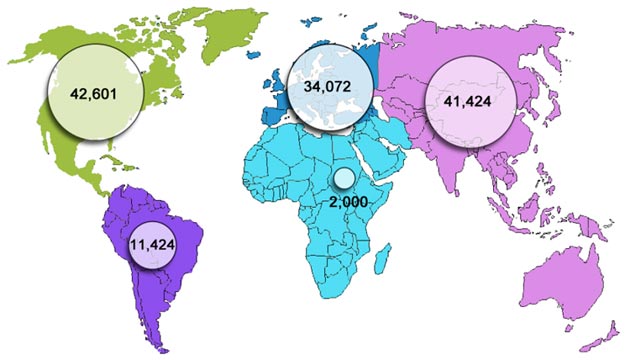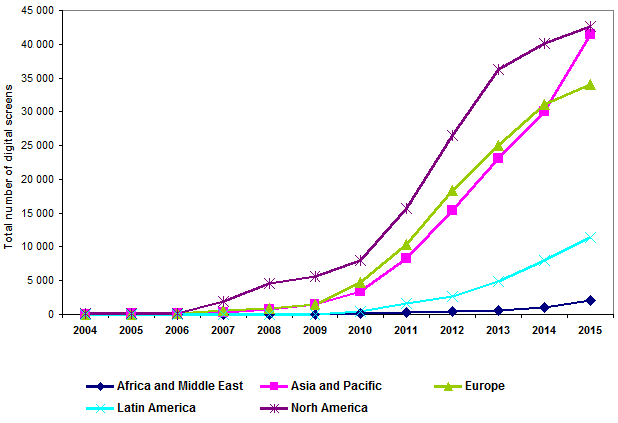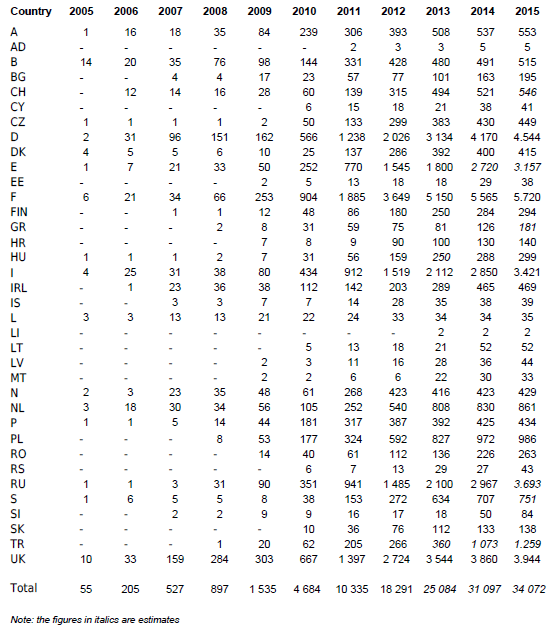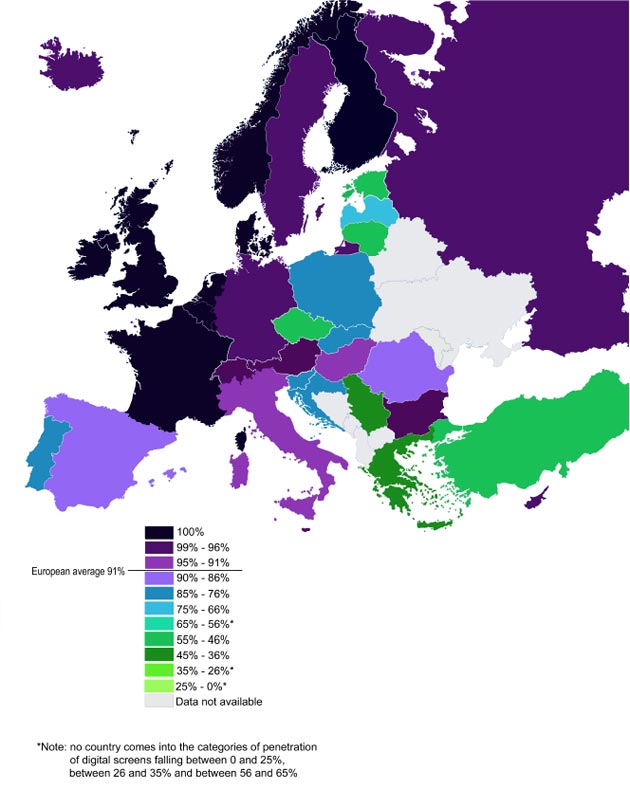|
|
As the digital roll-out nears completion, new educational needs arise
Now with the digital conversion nearly complete, the need for education has only begun. New decisions must be made. This is because digital motion picture technology makes it possible to introduce an unlimited array of new capabilities not considered when the Digital Cinema Initiative (DCI) specification was first created. Just as owners of the first Apple iPad have come to learn, one needs to upgrade or replace their existing device to benefit from the latest features available in the marketplace. But unlike for owners of the first iPad, it's not so easy to offset the investment in a new projector by selling the old projector into a secondary market. There is no secondary market, as the bulk of the transition took place with brand new equipment over a 5-year period.
There are other complexities to the financial situation, too. Major motion picture studios were willing to subsidize the transition to digital projection through a mechanism called the virtual print fee (VPF). In effect, the VPF subsidy shares with exhibitors the savings studios will realize over the first 10 years of the transition. But the VPF subsidy is a one-time event. Without a secondary market for older equipment, and without a future subsidy, exhibitors will be faced with substantial capital expenditures for the latest cinema systems. Those investments will need to be carefully placed, else their businesses will be at risk.
|
While major Hollywood motion picture studios were able to successfully drive the digital transition, the next wave of changes will be driven by other market forces. Manufacturers are keen to sell new innovations, such as new sound system technologies and new projection technologies, with features that may include higher dynamic range, high frame rate, larger color gamut, and higher light levels for 3D. In addition, new capabilities designed to improve operations are beginning to find their way into the market. None of these innovations were envisioned in the original DCI specification.
With the transition nearly complete, marketplace dynamics are reverting to that of earlier days in cinema, where sellers drove innovation, and buyers would pick and choose. However, today is different from yesterday, in that technology is advancing at a much faster pace, and the cinema market is now highly leveraged, after investing over 5B Euro in new digital projection equipment worldwide. The combination of rapidly changing technology in a highly leveraged market could lead to disaster for small/medium sized exhibitors if ill informed when making new investments in their business. |
|
|
|
| WOMEN IN DIGITAL |
Cristina Santagiuliana,
Business Development Manager, Open Sky
 I had already started to be drawn to the world of show business even before I started high school. I knew that I would be studying economics at university but the dynamics of show business made me very curious: I liked the idea of organizing and working for artists, especially musicians. That's why, in 1997, after I obtained my high school diploma, I decided to choose a course of international studies: International Business, specializing in event management. I graduated four years later at Nottingham Trent University and on my return to Italy, after an experience in Australia lasting several months, I had the chance to collaborate with all the biggest organizers of music events in Italy through my little company, Planet Wave.
In my seven years as production assistant, I gained invaluable experience both professionally and in terms of human relationships, not to mention my own personal growth. What gave me greatest pleasure was the successful conclusion of projects that were all different from one another. It was always an exciting commitment: different problems to solve, the people I worked with experienced things differently and had specific demands. It meant stress, adrenalin and the final satisfaction when the artists went on stage and my exhaustion disappeared with the audience's acclaim.
This experience forged my love of challenge and that's why, when the experience of Planet Wave came to an end, I accepted the proposal from Open Sky. It was 2009. The company was then in its start-up phase, as its Cinema division with its first broadcastings of live events had been launched only a year previously.
The show changed: from live events I shifted to cinema, always behind the scenes. It was a totally unknown sector to me: from pure organization I moved to technology, the only woman amongst the technicians and engineers! A new challenge took shape on my horizon: on the one hand, to create the network of cinemas equipped with the Open Sky satellite kit, on the other, to form relations with the distributors, so that Open Sky became the preferred carrier for their digital films. Satellite cinema in Italy was yet to be invented and Open Sky created it.
Initially I was to have dealt with live events only but in the months that followed, as "business developer" of Open Sky Cinema, I contributed to bringing to life a new market and had the opportunity to experience first-hand the whole process of digitalization of movie theatres and content, alongside the exhibitors and distributors. It was a long transformation, sometimes hard because of the investments necessary but also because of the cultural resistence that all radical changes imply. To overcome this, Open Sky had - and continues to have - the right arguments: the quality of the product and of assistance. To sum up, being a precursor of its times, Open Sky has the future on its side. And so today, six years on, I can safely say that I'm satisfied with the results Open Sky has obtained: in Italy around 600 cinemas are equipped with our kit for satellite reception, representing 86% of the market out of the total Cinetel box office.
Finally, I'd like to return to the question of challenge, in connection with the new service we launched at the end of 2014, i.e. the On Demand service. This is a new dimension in the delivery of digital content, which uses the broadband digital terrestrial connection. We created the On Demand platform to give distribution the chance of making more prolonged use of titles and to make the most of the library, whilst exhibitors were offered the possibility of rendering their programming more flexible and personalized, a tool whereby they could get hold of titles easily without wasting time and energy. By using our On Demand service, the exhibitor has the films available when he actually needs them, enjoying the maximum flexibility of the download for single transmissions.
Digital cinema is not yet at the end of its evolution. (Per leggere il testo in italiano cliccare qui) |
|
|
| ALL DIFFERENT ALL DIGITAL |
|
This column hosts portraits of cinemas in Europe and the rest of the world which are quite different from one another but have in common the fact that they have all adopted digital projection.
Aero Kino
Country |
|
|
No. of screens |
Czech Republic |
Aero Kino |
Prague |
1 |

Cinema Aero is one of the oldest art-house cinemas in Prague built in 1933 in the courtyard of a residential house in a purely functionalist style. In the 1990's it was a legendary film club with a program consisting mainly of premiere art films and classic film retrospectives. Now it is a strong single screen cinema where you can find a selection of current film premieres and specialized film festivals (focusing on specific directors, countries or film genres). The most popular festival is The Shockproof Film Festival, which features a range of obscure Z-movies, taking place in Aero every February. Getting (still) more and more popular are live transmissions from the Metropolitan opera in New York, the National Theatre in London or Royal Shakespeare Company in Stratford upon Avon in Cinema Aero program. An important part of the cinema is also the bar - where you can discuss the fresh film experiences right after watching the film on our screen. The bar premises also function as a gallery of film posters.
Aero is part of the Aeropolis arthouse cinema chain, a Czech company that has a clear strategy on building an online community: its 5 theatres all have a different and unique look on their websites and social platforms. The websites are redesigned every 5 years and provide a lot of up-to-date information in a simple and well arranged way which is easy on the eye. With a quality website connected to social networks an effective online campaign can be enabled, such as, for instance, the series of events comprising Aeropolis' "Cinema Royal", which involves screening a series of films in unusual places in Prague - similar to Secret Cinema in the UK. Meeting points for the screenings are revealed only a day ahead. The title of the film remains a mystery until the beginning of the screening and the latter is often followed by live performances and a party with DJs. The events have taken place, for example, in a boxing gym (for the screening of Rocky), a high voltage laboratory (Metropolis), a shopping centre (Dawn of the Dead) and the Prague racecourse (The Sting). All communications regarding the events take place entirely through Facebook and a
newsletter.
Only small clues - like dress code - are communicated beforehand. The ticket price is around 15 euro and the event is targeted at well-off, young city dwellers, with the view of attracting new audiences. The online community obviously plays an important part in this alternative audience-building strategy. In fact, Cinema Royal has 14,000 addresses in its mailing list and 6,000 facebook fans, while 300 to 700 people attend each event.
|
Aero will be visited during DigiTraining Plus 2015 |
|
|
| |
| NOT ONE LESS |
The process of digitalization in cinemas, albeit with considerable differences from territory to territory, is reaching its final phase and the so-called "switch-off" for traditional film is almost complete. But which cinemas have not yet converted to the new technology? And why? This column has been opened to find answers to these questions, presenting portraits of cinemas in Europe that have not yet digitalized or that are still looking for a way to deal with the shift.
Teatro dei Fabbri
By Elisabetta Galeffi
|
|
|
|
Italy |
Teatro dei Fabbri |
Trieste |
1 |

Trieste is a city where people still go to the cinema! Movie theatres haven't disappeared from the city streets and at the end of January the Trieste Film Festival is held: a collection of documentaries, full-length features and short films where the audiences decide the awards.
Trieste is a city of theatres where people are out in the streets not only in the summer season along the sea front, in the squares that act as salons or the historical streets, but in winter, too. People confront the terrible bora wind, meeting in the nineteenth-century cafés or in one of the many different styles of restaurant, always full of people and conversation. A border city located between different worlds, where history dialogues with the contemporary, this sea-faring city is always doing its best to reinvent itself, maintaining its pride of place as a great Mediterranean port.
The "Teatro dei Fabbri" is a small theatre in the road of the same name - Via Fabbri (Blacksmiths Road) - in the midst of Trieste's little streets which start off with a gradual slope but risk becoming extremely steep higher up.
The cinema was a small theatre up to only a short time ago, as the sign still shows. Two years ago, the manager - Isidoro Brizzi - a prominent figure on the panorama of cinema in Trieste - turned it into an art-house cinema and placed all his odds on re-launching independent, European films. Judging by the initial balance sheets, this ambitious gamble has been a winner. "It's an upward path to keep a cinema going today, but it can be done," admits Brizzi. He does everything himself, from selling tickets to choosing the films, which he looks for on the less advertised circuits, and thanks to the immense possibilities offered by the web. "I look for independent films, especially European ones, although I sometimes manage to offer an independent American film, too. I get advice and tips on good titles that aren't to be found on the large distribution circuits from cinema-loving friends who attend the festivals - Cannes, Venice, Berlin. I no longer have time to leave the theatre myself".
Small-scale distribution allows screenings to be organized differently with a wider range of titles, which are screened in electronic format. Two films a day, mostly in the original language: one option for the afternoon and another for the evening, with a programme that changes every week.
At least for the moment there is no digital projector in the Fabbri theatre, and not even 3D or a satellite connection. Its success with audiences has been gained thanks to the right choice of films and different genres. Today, for example, the offer ranges from a collective work on a historical topic, like the film "Les Ponts de Sarajevo" on the First World War, to the intimate story told by "Violette" about Simone de Beauvoir and her friend Violette Leduc.
The cinema once again becomes a place to escape to on a boring Sunday and discover that there are still stories to be told.
(Per leggere il testo in italiano cliccare qui) |
|
|
KEY STATISTICS FROM MEDIA Salles |
92% of worldwide screens are now digital, but some territories are still striving for innovation
by Elisabetta Brunella
2015 opened with almost one hundred and thirty-two thousand digital projectors (NOTE 1) installed all over the world. The figure had increased on average by 19% compared to 2014. Nonetheless, the analysis by continent shows that, although growth is generalized, the areas that already boasted the highest penetration rate, i.e. North America and Europe, saw the percentage of digital screens in their area grow by only 6% and 10%, respectively. Instead, growth was well above average in Asia and the Pacific Rim (approx. +38%), Latin America (over 42%) and, even higher, Africa and the Middle East (+106%).
If, up until 12 months previously, North America had had the lion's share, with over 40,000 units, whilst both Europe and Asia with the Pacific Rim stood at around 30,000, at the beginning of 2015 North America and Asia with the Pacific Rim record more or less the same number of digital screens: around 42,000.
Europe, which acquired 3,000 digital projectors, just passes the 34,000 mark. Latin America, which, however, now has more than 11,000 screens and, even more so, Africa and the Middle East, with a total of around 2,000 units and double the screens present in 2014, continue to remain some way behind.
DIGITAL SCREENS - SITUATION WORLDWIDE, AS AT 1st JANUARY 2015

DIGITAL SCREENS - SITUATION WORLDWIDE, AS AT 1st JANUARY

DIGITAL SCREENS - SITUATION WORLDWIDE, AS AT 1ST JANUARY

If we consider the penetration rate, it can be seen that the new technology has now reached around 92% of total screens (NOTE 2).
In Europe MEDIA Salles' findings show that during 2014 the number of digital screens rose from 31,097 to 34,072. 2,975 new projectors were thus installed, about half of those installed the previous year (6,013), which is due to the fact that many countries were already fully digitized.
At the start of 2015, in fact, 91% of European theatres prove to be digital, a penetration rate only slightly lower than the world average, which comes to around 92%. The difference compared to North America is, instead, more marked. In the latter country 98.5% of screens had shifted to the new technology by the beginning of 2015.
DIGITAL SCREENS IN EUROPE BY COUNTRY, AS AT 1st JANUARY

Of Europe's 34,000 digital projectors, around 72% are situated on the six leading markets, with a slight increase compared to the previous twelve months (when the figure was 71%): the leading six European countries, in which around 68% of the Continent's total screens are concentrated (also counting theatres that have not yet been converted), thus continue to maintain their leading position over other countries as regards the adoption of the new technologies.
In terms of the total numbers of units installed, France is in first place (5,720), followed by Germany (4,544) and the United Kingdom (3,944). In 2014 these three countries saw a lower increase in their digital equipment than the Continent's average, respectively 3%, 9% and 2%. In fourth position comes Russia (3,693 digital screens), followed by Italy (3,421) and Spain (3,157). With growth rates well above the European average, i.e. 24%, 20% and 16%, these three countries have closed the gap with the leaders.
DIGITAL SCREENS IN THE 6 MAJOR EUROPEAN MARKETS, AS AT 1st JANUARY

Nevertheless, even on these six leading markets, there are considerable differences in terms of the penetration rate of digital screening.
Alongside markets that have completed their conversion to digital, such as France and the United Kingdom, or which are close to this objective, such as Germany with 98% and Russia with 96%, are the situations of Italy, which, with 91%, is in line with the average for the Continent, and Spain, still below average with 88%. As regards Spain, in 2014, too, the increase in the Country's penetration rate, rising from 70% to 88%, is linked both to the increase in digital installations and to a considerable drop in the total number of screens, which signals a troubled market which, over the past few years, has achieved both a positive record of almost 144 million admissions (in 2004) and a negative one of only around 79 million tickets sold in 2013.
The disparity on the leading markets is also reflected in those of the smaller countries.
DIGITAL SCREENS PENETRATION RATES IN EUROPE BY COUNTRY, AS AT 1st JANUARY 2015

Alongside countries where 35mm has practically disappeared - both in exhibition and in distribution - (the case of Scandinavia, Benelux, Austria, Switzerland, to quote a few), there remain countries where the spread of the new technology is decidedly below the average for the continent.
Though with clear differences between them, the latter include Serbia, Slovakia and the Czech Republic, as well as the Baltic Republics. Amongst the latter, Latvia has nonetheless grown by 14 points, up to 69%. Similarly, Slovenia, though remaining below the average for the continent, has experienced quite significant growth compared to twelve months previously, rising from 45% to 79%.
In conclusion, at 1st January 2015, of the 36 countries examined by MEDIA Salles, there are thirteen where digital screens fail to come to 90% of the total.
MEDIA Salles' findings for these cinemas show that the results are often due to so-called traditional management, i.e. single-screen cinemas belonging to independent exhibitors, frequently located in small-medium sized towns. Careful attention thus needs to be paid to this situation: the risk that the difficulty in converting to the new technology may result in closure cannot be excluded.
NOTE 1: Projectors using DLP Cinema TM or SXRD TM technology.
NOTE 2: MEDIA Salles estimates that at the start of 2015 there were over 142,000 commercial screens worldwide, an increase of approx. 6% compared to the previous year.
This text is part of the "Focus on digitization in Italy and abroad" drawn up by MEDIA Salles and published in "Rapporto 2014. Il mercato e l'industria del cinema in Italia", issued by Fondazione Ente dello Spettacolo and Direzione Generale Cinema - Ministry of Culture.
(Per leggere il testo in italiano cliccare qui)
|
|
 |
| MEDIA Salles' latest get-togethers: for learning, sharing, networking
|
|
Presentation of the "Yearly Report on the Italian Cinema Industry", including the MEDIA Salles "Focus on digitization"
 On July 15, the "Yearly Report on the Italian Cinema Industry" - an initiative by Fondazione Ente dello Spettacolo and Direzione Generale Cinema - MiBACT, was presented in Rome. On July 15, the "Yearly Report on the Italian Cinema Industry" - an initiative by Fondazione Ente dello Spettacolo and Direzione Generale Cinema - MiBACT, was presented in Rome.
It includes a "Focus on digitization" drawn up by MEDIA Salles and commented on by Paolo Protti, President of MEDIA Salles, who stressed the importance of the upcoming second phase of the digital roll-out, i.e. the replacement of projectors nearing obsolescence. How can exhibitors deal with this? Can we imagine a new version of the VPF model and the public support scheme?
To see Paolo Protti's talk, click here (Italian version).
At Cineurope 2015
On June 22, MEDIA Salles and Rising Alternative invited their friends and partners to a "happy hour" on the 25th floor of Princess Hotel, in Barcelona: a great view and an invigorating breeze from the Mediterranean Sea were the distinctive features of this gathering centring on the presentation of the upcoming "DigiTraining Plus course" and the latest edition of the DiGiTalk.
Click here to see the Photogallery.
|
|
|
MEDIA Salles
Piazza Luigi di Savoia, 24 - 20124 Milano - Italy
Tel.: +39.02.6739781 - Fax: +39.02.6690410
E-mail: infocinema@mediasalles.it |
|
|
|



 I had already started to be drawn to the world of show business even before I started high school. I knew that I would be studying economics at university but the dynamics of show business made me very curious: I liked the idea of organizing and working for artists, especially musicians. That's why, in 1997, after I obtained my high school diploma, I decided to choose a course of international studies: International Business, specializing in event management. I graduated four years later at Nottingham Trent University and on my return to Italy, after an experience in Australia lasting several months, I had the chance to collaborate with all the biggest organizers of music events in Italy through my little company, Planet Wave.
I had already started to be drawn to the world of show business even before I started high school. I knew that I would be studying economics at university but the dynamics of show business made me very curious: I liked the idea of organizing and working for artists, especially musicians. That's why, in 1997, after I obtained my high school diploma, I decided to choose a course of international studies: International Business, specializing in event management. I graduated four years later at Nottingham Trent University and on my return to Italy, after an experience in Australia lasting several months, I had the chance to collaborate with all the biggest organizers of music events in Italy through my little company, Planet Wave.










